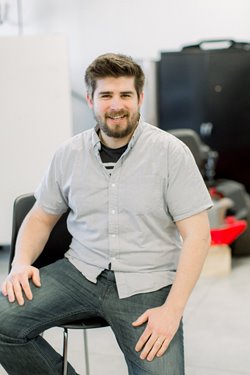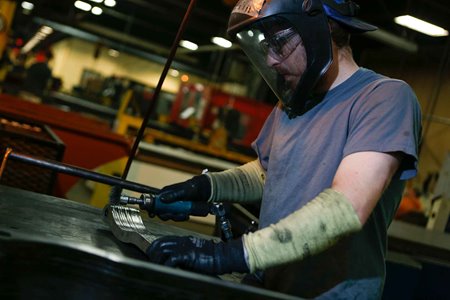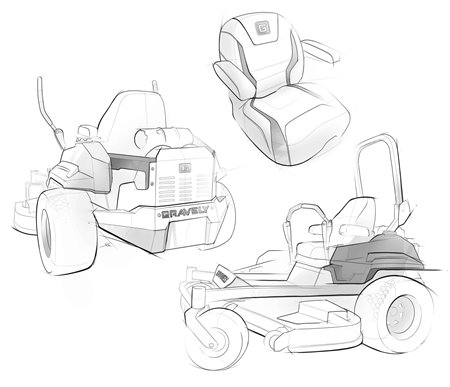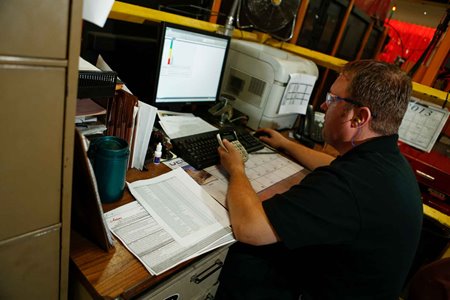
Industrial design and mechanical engineering have been central to the success of AriensCo throughout its long history. Innovation has always been the goal, and since the invention of the first American-made rotary tiller, AriensCo has continually introduced new products to the outdoor power equipment industry that blend cutting-edge technology with usercentric design. From snow throwers to zero-turn mowers, and now with the introduction of its first battery-powered mower, the EVZT, AriensCo’s industrial design process has produced machines that are durable, reliable and easy to use — the hallmarks of great design engineering.
This tradition continues today at AriensCo’s headquarters in Brillion, Wisconsin, where a team of industrial designers is constantly at work on the next evolution of Gravely and Ariens machines. Out Working went behind the scenes with Principal Industrial Designer Grant Gierosky and Senior Industrial Designer Andrew Donati. The two specialize in drafting the first iterations for the next generations of equipment. Their industrial design process puts the user at the center of the experience while combining leading-edge technology and marketplace trends to ideate new machines. They are masters of working with cross-functional teams from across AriensCo to create equipment that merges form, function, efficiency and cost.
“It takes several different teams from across the company to work together to build the next great AriensCo piece of equipment,” Gierosky said. “It’s a long, rigorous process of taking a broad idea and distilling it down piece by piece to get a final product that represents the brands well and also meets our customers unique demands.”
The design process tends to be both evolution and revolution for AriensCo — new equipment designs are built upon the designs of previous models in a state of continual evolution. Often the industrial design team is tasked with updating a current model in the Ariens or Gravely range to accommodate changes in users’ habits, emerging technologies, marketplace trends or breakthrough innovations. Completely new products, like the upcoming EVZT electric zero-turn mower, fall on the revolutionary side of the spectrum.
No matter the primary reason for a new equipment design, the industrial design team always has the user at the center of the equation. The team is always trying to address a challenge: “How can we improve this element for our users?” It is not enough to simply include new technologies. The team must improve the user experience and deliver them return on investment.
While the industrial design team is tasked with creating the initial look of a new piece of equipment, an idea can come from anywhere within AriensCo, its customers or even its dealer network. The design team must assemble the best ideas from a variety of teams, including engineering, research, electrical and mechanical teams, marketing and more. It’s at the intersection of several schools of knowledge where the best equipment designs emerge.
The ideation phase starts with getting initial ideas sketched out on paper, and then what the final piece of equipment might look like begins to take shape. The team can then see what parts, materials and features to include before moving into the rendering, CAD and virtual reality phases. Virtual reality technology enables the team to get a 3-D view of their idea. Just as scientists form hypotheses, the design team begins to brainstorm for solutions to new challenges before it moves on to experimenting with physical models, working as efficiently as possible by limiting manual labor.
The industrial design team will test out several possible solutions to a challenge during their process. Equipment designs can change dozens of times at this phase, all with a wide range of results that then inform the next round of testing. The Gravely EVZT, for example, originally was tested with its interface screen on the rear of the mower, but after experimenting, the team dramatically changed the frame shape and moved the screen to the front of the machine where the operator could easily view it.
“Both Andrew and I went to art school and specialized in industrial design,” Gierosky said. “We draw inspiration from a lot of places: everyday life, magazines, media, sporting goods and much more. When we are given a direction, we come up with design pillars, such as whether it’s a lightweight or minimal look or the opposite. An aesthetic begins to take shape. Then we look at the elements we want to include on the machine that influence its overall look, like fenders, gas tanks, seats and lighting.”
Decisions about what features to include on a new machine are made with input from the crossfunctional teams with various expertise. One design choice can create a sliding scale of choices that affect the overall finished product. The teams work together to provide input and adapt to their colleague’s priorities. Performance, looks, market trends, new technologies, release schedules and a multitude of other factors can influence the machine’s design. The teams work to find the best balance among all of the competing factors while keeping the user as the focal point.

No matter the challenge, the most important thing is that the machine has to work, and it has to work within regulations. The teams consider the physics of operating the machine, along with user comfort, electrical and mechanical performance and safety and compliance regulations. With laws regarding emissions changing at a rapid pace, for example, the cross-functional teams work to ensure that new machine designs will not just meet the specifications of today, but also of the foreseeable future, ensuring value for their owners.

Once a near final product is built, it goes through a market research phase where it is tested by potential customers and reviewed by dealers. It’s important for the team not to get complacent throughout this process because feedback can root out suboptimal features, inefficiencies and design missteps. On the flip side, the industrial design team can spot opportunities for improvement, efficiency and ease of use. The team must be able to pivot quickly and adapt to this feedback to ensure quality design.

“It’s very rewarding to see a project completed, whether it’s a redesign or a revolutionary new machine,” Donati said. “It takes a tremendous effort from all the teams involved to find the right balance of features and mechanical elements that work together to form a complete machine that customers like and want to use. It’s satisfying to see a new piece of equipment do well in the marketplace, and we always enjoy hearing that our customers value their machines. If we do our job right, it will help them do their job better.”